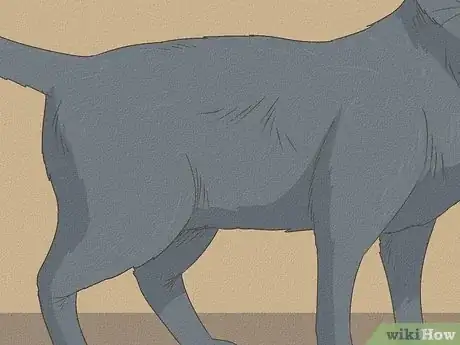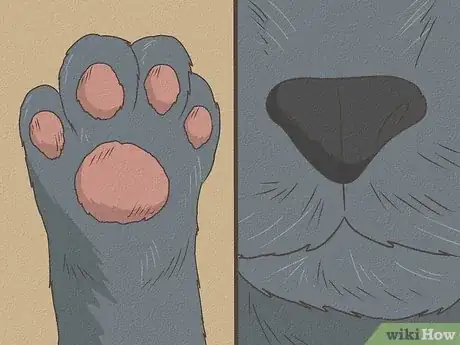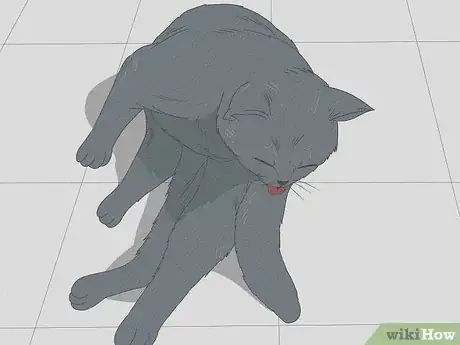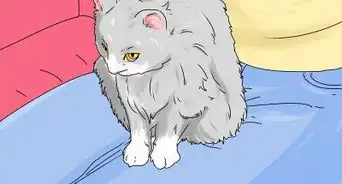This article was co-authored by Pippa Elliott, MRCVS and by wikiHow staff writer, Eric McClure. Dr. Elliott, BVMS, MRCVS is a veterinarian with over 30 years of experience in veterinary surgery and companion animal practice. She graduated from the University of Glasgow in 1987 with a degree in veterinary medicine and surgery. She has worked at the same animal clinic in her hometown for over 20 years.
There are 10 references cited in this article, which can be found at the bottom of the page.
wikiHow marks an article as reader-approved once it receives enough positive feedback. This article has 24 testimonials from our readers, earning it our reader-approved status.
This article has been viewed 670,898 times.
Have you ever come across a stunning gray cat with beautiful green eyes? The odds are good you’re looking at a Russian Blue. These mysterious and stunning cats make phenomenal companions, which is part of why they’re so popular and sought after as pets. But before you adopt or buy a purebred kitty, you likely want to confirm you’re actually looking at a Blue and not some other kind of gray cat. In this article, we’ll break down everything you should look for to identify a Russian Blue.
Things You Should Know
- A silvery blue coat and stark emerald eyes are the major indicators that you’re looking at a Russian Blue.
- Russian Blues typically have angular wedge-shaped heads and a distinct slight “smile” that resembles the Mona Lisa.
- Behavior-wise, Russian Blues tend to be very judicious, quiet, and shy, but they’ll be a friend for life once you two bond!
Steps
Physical Characteristics
-
1Distinctive silvery coat with a bluish sheen
The most striking and unique thing about a Russian Blue is the coat for which it is named. It appears silvery grey, although this deep and dynamic color is often described as blue depending on the light and angle you’re looking from. This is where the name comes from. It should be dense, thick, plush, and double layered.[1]- If you look carefully at individual hairs, you will find a grey shaft tipped with lighter grey or silver at the tip.[2]
-
2Black nose and mauve paw pads
The mauve paw pads are a big giveaway you’ve got a Russian Blue as opposed to some other breed of gray cat. Most of the other breeds that come in gray will have gray or black paw pads.[3]Advertisement -
3Deep and striking emerald eyes
Russian Blues have a distinctive green eye color. There is no other eye color for a Russian Blue. This trait starts to develop from 4 months of age and manifests as a rim of green around the outside of the iris, which is the colored part of the eye. All kittens are born with blue eyes, but the color changes to the final adult shade once they get older.[4]- Many people assume the “blue” in “Russian Blue” refers to the eyes. It’s actually the fur coat, though!
- Pro-tip, if you’ve got a gray cat with blue eyes, you’re probably looking at a Ragdoll cat.
-
4Small, upturned smile
Partially due to the shape of their heads and partially due to some genetic quirk, Russian Blues have a slightly round and upturned mouth, which can make these cats look like they’re smiling. It’s a subtle smile, but it’s there![5]- If you can’t see it, call a Russian Blue’s name when they’re sitting down and you’re standing up. It’s easier to see the smile when the cat looks up at an angle since their neck fur isn’t in the way.
-
5Wedge-shaped and angular head
Russian Blues have a characteristic wedge-shaped or triangular face, which is often described as cobra like with seven distinct planes. Typical cats, in contrast, tend to have a rounder, more apple like skull. This sets Russian Blues apart.[6] -
6Average body size
Russian Blues typically grow to be around 10 inches (25 cm) in height and on average they weigh around 12 pounds (5.4 kg). This is extremely average in the context of all the cat breeds out there, so if the cat seems really big or exceptionally stout, it probably isn’t a Russian Blue.[7] -
7Slim, muscular build
Russian Blues give an overall impression of being long, slender, and elegant. They have a long graceful neck when it’s stretched out, but the deep plush coat can disguise this and make the neck appear shorter. If you feel like the cat is lean, muscular, and long, it could be a Russian Blue.[8]- Blues don’t tend to be exceptionally chunky or robust, the way the average Persian or Main Coon is.
Behavioral Characteristics
-
1Shy and reserved personality
Studies demonstrate that Russian Blues are among the most fearful of cat breeds, especially when it comes to strangers. If the cat seems uniquely judicious and shy—even for a feline—there’s a very good shot you’re looking at a Russian Blue.[9]- This translates to the way Russian Blues behave around other cats and pets, as well. Blues don’t typically jump at the chance to hang out with new animal friends.
-
2A gentle and affectionate disposition
Russian Blue’s are delicate cuddlers who won’t push you or throw a fit if you don’t want to pet them. A lot of breeds out there, like Assyrians and Norwegian Forest Cats, will paw at you, scratch, meow, and pester you until you pay attention to them. Not the Russian Blue. These gentle kitties will patiently sit nearby and wait for your love.[10]- Blues are great observers and love to actively watch what's going on around them, without necessarily joining in. Like many cats, they are lovers of peace and will prefer to retire to a quieter spot while noisy activities such as vacuuming take place.[11]
- This is part of why people think it’s so easy to care for a Russian Blue but they require just as much attention as any other breed of cat.
-
3Minimal meowing
Russian Blues are among some of the quietest cat breeds out there. They don’t tend to talk up a storm when they’re hungry and you’re unlikely to hear a Russian Blue putting on a show at 4 am by meowing through the night. They won’t be completely mute—especially if you startle them—but they’re relatively quiet for a cat.[12]- As a note, this is also true for the Chartreux, another breed of gray cat often mixed up for the Russian Blue. You can always tell them apart by the eyes. Chartreux kitties have bright orange eyes.
- Russian Blues have a reputation for having a quiet meow, not a loud, boisterous meow like the Siamese or Javanese. These breeds can be extremely vocal and screechy.
-
4Self-play when alone
Russian Blues are one of the few breeds of cat that will have a blast playing all by themselves. If you catch the cat romping around with a stray sock or chasing a shadow on the wall in a room you aren’t in, you’re looking at vintage Russian Blue behavior.[13]- This isn’t to say that a Russian Blue won’t want you to hang out with them and play if you two bond.
- One of the breed’s unique quirks is that they tend to enjoy playing fetch, which is pretty unusual among cat breeds.[14]
-
5Exceptional grooming routine
The Russian Blue is notorious for being easy to clean up after and groom. They spend an inordinate amount of time grooming themselves and cleaning up after any loose furs. If you’re looking for a uniquely neat kitty, this is a great breed for you.[15]- This is part of why Blues are considered to be (mostly) hypoallergenic.
Expert Q&A
-
QuestionWhat is the rarest color of cat?
 Pippa Elliott, MRCVSDr. Elliott, BVMS, MRCVS is a veterinarian with over 30 years of experience in veterinary surgery and companion animal practice. She graduated from the University of Glasgow in 1987 with a degree in veterinary medicine and surgery. She has worked at the same animal clinic in her hometown for over 20 years.
Pippa Elliott, MRCVSDr. Elliott, BVMS, MRCVS is a veterinarian with over 30 years of experience in veterinary surgery and companion animal practice. She graduated from the University of Glasgow in 1987 with a degree in veterinary medicine and surgery. She has worked at the same animal clinic in her hometown for over 20 years.
Veterinarian A true fawn color, without any tabby markings, is very rare. Also, lavender or lilac (a gray with a true blue tinge) is extremely uncommon.
A true fawn color, without any tabby markings, is very rare. Also, lavender or lilac (a gray with a true blue tinge) is extremely uncommon. -
QuestionCan a Russian blue have yellow eyes?
 Pippa Elliott, MRCVSDr. Elliott, BVMS, MRCVS is a veterinarian with over 30 years of experience in veterinary surgery and companion animal practice. She graduated from the University of Glasgow in 1987 with a degree in veterinary medicine and surgery. She has worked at the same animal clinic in her hometown for over 20 years.
Pippa Elliott, MRCVSDr. Elliott, BVMS, MRCVS is a veterinarian with over 30 years of experience in veterinary surgery and companion animal practice. She graduated from the University of Glasgow in 1987 with a degree in veterinary medicine and surgery. She has worked at the same animal clinic in her hometown for over 20 years.
Veterinarian The official breed standard only accepts shades of green. Yellow eyes are discouraged, and therefore, breeders tend to avoid breeding from cats that err towards amber or yellow.
The official breed standard only accepts shades of green. Yellow eyes are discouraged, and therefore, breeders tend to avoid breeding from cats that err towards amber or yellow. -
QuestionWhat color eyes can a Russian blue cat have?
 Pippa Elliott, MRCVSDr. Elliott, BVMS, MRCVS is a veterinarian with over 30 years of experience in veterinary surgery and companion animal practice. She graduated from the University of Glasgow in 1987 with a degree in veterinary medicine and surgery. She has worked at the same animal clinic in her hometown for over 20 years.
Pippa Elliott, MRCVSDr. Elliott, BVMS, MRCVS is a veterinarian with over 30 years of experience in veterinary surgery and companion animal practice. She graduated from the University of Glasgow in 1987 with a degree in veterinary medicine and surgery. She has worked at the same animal clinic in her hometown for over 20 years.
Veterinarian The ideal eye color is green, with brighter shades such as emerald favored.
The ideal eye color is green, with brighter shades such as emerald favored.
References
- ↑ https://cfa.org/russian-blue/
- ↑ http://www.catbreedslist.com/all-cat-breeds/russian-blue.html#.VcCw5flViko
- ↑ https://upgradeyourcat.com/mauve-footpads-which-breeds-and-colors-have-them/
- ↑ https://cfa.org/russian-blue/
- ↑ https://www.petmd.com/cat/breeds/c_ct_russian_blue
- ↑ https://cfa.org/russian-blue/
- ↑ https://vcahospitals.com/know-your-pet/cat-breeds/russian-blue
- ↑ https://www.petmd.com/cat/breeds/c_ct_russian_blue
- ↑ https://www.mdpi.com/2076-2615/11/7/1991
- ↑ https://vcahospitals.com/know-your-pet/cat-breeds/russian-blue
- ↑ https://cfa.org/russian-blue/
- ↑ https://www.animalfunfacts.net/pets/cats/671-cats-that-dont-meow-a-lot.html
- ↑ https://vcahospitals.com/know-your-pet/cat-breeds/russian-blue
- ↑ https://cfa.org/russian-blue/
- ↑ https://www.dailypaws.com/cats-kittens/cat-breeds/russian-blue
- ↑ https://laws-lois.justice.gc.ca/eng/acts/a-11.2/FullText.html
- ↑ https://vgl.ucdavis.edu/test/cat-ancestry
About This Article
To identify a Russian blue, look out for a cat that appears long and slender. Check to see whether the cat is around 10 inches tall to its shoulder, which is the average height for Russian blues. If you are looking at a Russian blue, you will also notice its thick, plush coat, and its distinctive green eyes. Examine the color of the coat, which should be a silvery gray and is the cat's most unique feature. If you're still unsure, ask the owner to see the cat's pedigree papers to determine whether it's really a Russian blue. For advice on how to get a DNA test for a cat, keep reading!










































































